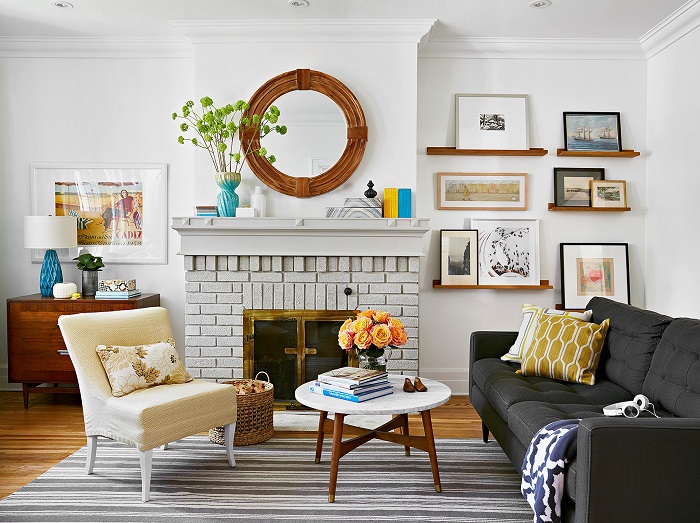
On a winter night, a warm, crackling fire is ageless, yet design trends vary. A classic brick fireplace may appear old-fashioned or out of place if your furniture or room décor changes. Brick is also renowned for absorbing soot and grime, and it is vulnerable to mould growth.
Remodelling the fireplace area is one option. However, this is time-consuming, untidy, and typically entails a significant financial outlay. Coating over the bricks in an older fireplace is not only faster, easier, and less expensive, but it is also very adjustable, allowing you to choose a colour or finish that complements the rest of the space.
Choosing the right paint for a brick fireplace takes some thought, depending on personal choice, existing décor, and colour schemes. Here are some of the most excellent alternatives for freshening up an old fireplace.
Advice on selecting the best paint for brick fireplaces varies because not all products are utilized in the same way. The following section looks at critical issues linked to how different types of paint function, followed by some helpful advice on how to paint a fireplace that will ensure practical application.
Because brick fireplace surrounds do not become extremely hot, the paint used on them does not need to be particularly heat resistant. Interior latex paint has a heat resistance of around 180 to 200 degrees Fahrenheit, more than enough.
The same is valid with masonry paint, where the main issue is withstanding low temperatures outside. It's unknown what chalk paint's particular heat resistance is, but it's been used effectively on fireplace surrounds many times.
It's critical to note that these materials are intended for painting the exterior of the fireplace rather than the interior. Painting the firebox itself necessitates the use of specialized high-temperature paint.
The Colour for a painted brick fireplace is also a highly personal choice. However, no matter your current décor or decorative style, selecting an acceptable colour should be simple. Interior acrylics are available in a variety of hues, and white bases may generally be coloured. Chalk and masonry paints are available in a range of shades as well.
Sheen, often known as gloss, defines how the paint reflects light. Flat has the least amount of shine, followed by matte, eggshell, satin, semi-gloss, and gloss (or high-gloss) at the other end of the spectrum. Personal preference will influence the decision, although high-gloss finishes are uncommon on brickwork and challenging to produce because of the surface roughness. The most popular finishes are flat, matte, or eggshell.
Whether or not to use a primer is an intriguing topic that will depend on the intended result. Some individuals prefer a transparent finish, which allows some of the original brick colour to come through. Chalk paint can be used to achieve the well-known German Smear effect. In some instances, a primer is not required.
Brick, on the other hand, is highly absorbent. If a solid colour conceals the brick is desired, even acrylics with priming seldom offer adequate coverage in a single coat. You have two options: apply a second layer or use a primer first. Even the best primers are generally less costly. They frequently dry faster.
But it's not just about colour depth. Primers are meant to bind to the brickwork, sealing it and giving more excellent adhesion for the topcoat. Primers may also contain mould and stain blockers, which will keep the painted fireplace looking flawless for a more extended period.
All In One Renovations has already discussed how to paint a brick fireplace. Some of the main topics are presented below for your convenience.
Now that you've learned about the many factors that will influence your decision, it's time to look at some of the most delicate paint for brick fireplaces. These best selections have been divided into categories based on the sort of finish you want, the appearance you wish to, and other factors.
Given the different ways to paint a brick fireplace and the diversity of colours used, selecting a single best product was challenging. The ONE Paint and Primer is first due to its ease of application, quick drying time, and good coverage.
Another advantage of The ONE is its ability to work on many surfaces. It can also be used on wood, making it easier for the decorator to harmonize the rest of the room's elements.
Valspar Signature, marketed as a paint that "stands up to everything," delivers a durable surface that can survive everyday scuffs and stains—especially useful in a busy home where the fireplace receives a lot of usages.
Although this paint contains priming, painting fireplace brickwork usually necessitates using different primers to get the desired effect.
Even though "one coat" paints fight with the amount of colour that bricks and mortar absorb, a priming layer is usually required when painting a brick fireplace. Two or more applications are generally necessary if the aim is to cover the original hue.
Behr masonry paint repels water, resists mildew, and produces a very durable surface that can last up to 20 years.
Whitewashed brick has a timeless appearance that suits a wide range of decorative styles. Giani Brick Transformations' whitewash paint is a water-based solution that is ecologically safe and simple to apply.
 Call Now
Call Now